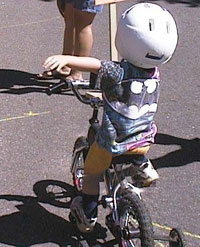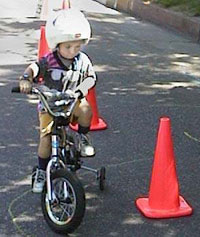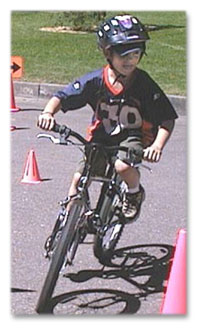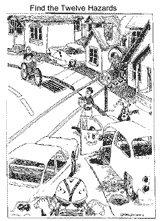Young Bicyclists
Bike Rodeo Kit
To help children learn bicycle safety, the City of Fort Collins has developed a detailed "Bike Rodeo Kit", and is making it available free of charge to local organizations, schools, service clubs and individuals in the Fort Collins area.
This self-contained kit is designed so anyone can easily conduct a successful bicycle rodeo. You'll find it complete with:
- instructions
- diagrams
- visual aids
- riding obstacles
- information
- other assorted materials
All materials are placed in a handy container on wheels. It's easy to use, and the exercises can be adapted for any size group.
To reserve the bike rodeo kit, or for more information, just call your bicycle coordinator at 416-2411.


At a bike rodeo, children learn bicycle safety skills with riding obstacles, visual aids and more!
Strap & Snap
Strap & Snap is a lively, educational presentation that teaches children the importance of wearing bicycle helmets. The program was designed by Family Medicine residents to be presented in classrooms by resident or community physicians, and is endorsed by the Colorado Academy of Family Physicians.
The bicycle helmet message is an important one. Each year in the United States, bicycling-related injuries result in approximately 800 deaths, and 1.2 million visits to physicians. Children ages 5-14 years of age have the highest injury rates. Helmets prevent serious injuries, decreasing the risk of a brain injury by 88% and head injuries by 85%. Unfortunately, helmet use continues to be low among children, particularly in lower income neighborhoods.
The Strap & Snap program is designed for third graders. By third grade most children are riding a bike and are receptive to the message about preventing head injuries. They've heard that they should wear a helmet, and this program helps them understand why. In the Strap & Snap presentation they learn about the brain-what it looks like, what it feels like, and how it allows them to run, throw a ball, follow the story line in a movie and laugh at a joke. They get to see a Jello brain and learn that it feels a lot like the real thing. They put together a giant brain puzzle that shows how each area in the brain performs a different job, like balance and coordination, memory, emotion, and vision. And they play a spy game that illustrates for them how a person with a brain injury might perceive things-to give kids a sense of how it feels to struggle with simple tasks.
The presentation also illustrates the importance of a helmet in protecting the brain from injuries. A demonstration using an egg shows how a simple foam "helmet" prevents the egg from breaking when tossed around the classroom and ultimately dropped. The kids see the proper (and improper) way to wear a helmet, and they practice the tongue twister, "straight, strap, snug, snap." The tongue twister is a reminder of the proper way to wear a helmet:
- straight--the helmet should be straight and level with the ground
- strap--the straps should form a "V" around the ears
- snug--the helmet should be snug
- snap--the helmet should be snapped
At the end of the presentation, each child is given a pledge form stating that he or she agrees to wear their helmet when cycling, skateboarding, or rollerblading. The pledge is signed by both the child and their parent, and returned to their teacher for a special prize (such as a sticker, a coupon for a free ice cream cone, etc.) The pledge form encourages commitment and provides an opportunity for dialogue between the child and their parent around the topic of wearing helmets.
Each year, the Colorado State University Alumni Association helps provide funding for the helmets, and the Safe Kids Larimer County (970-495-7504 or www.safekidslcc.org) is the distribution and fitting center.
Remember

- A bicycle is not a toy, it is a child's first "vehicle"
- Children up to the age of 15 suffer the greatest number of bicycle crashes. The most common is referred to as the 'ride out' - leaving a driveway or other area and riding into traffic where other drivers may not see them.
- Boys ages 11 - 15 are at greatest risk from being involved in a bicycle crash resulting in fatality - simply because they ride more often according to crash data
- Boys ages 11- 15 are reported to be the age group least likely to wear a bicycle helmet
- With child obesity at an all time high, bicycling is a great activity to improve health and maintain weight
- Click here to link to the "Children" section of the Colorado Bicycling Manual for:
- Tips for parents
- When should a child start to ride a bicycle
- Fitting a bicycle
- When should a child start to ride in the street
- Transporting children by bicycle
Youth
- You are a child's greatest influence - whatever behavior you model they will emulate
- It is suggested that children under that age of nine do not ride in the street, but instead use sidewalks, where allowed, demonstrating basic riding skills before venturing onto roadways
- When crossing the street using crosswalks, dismount your bike to enter the crosswalk
- Encourage children to look left-right-left before riding into the street or negotiating intersections
- Always ride in the same direction as traffic
- Children should stop at all driveways or side streets when a motor vehicle is present or nearby
- Seek out bicycle safety classes
Helmets
- Colorado does not require helmets by law but it is the first line of defense in a bicycle crash
- Helmets, when worn correctly, can reduce the incidence of head injury by almost 85 percent
Activities

Print off this page (PDF) and find the 12 pictured bicycling hazards with your children.
-
Find the 12 Hazards Activity Sheet (PDF)
The free Adobe Acrobat Reader is required - Answers to Find the 12 Hazards
For a list of youth and cycling links, click here
